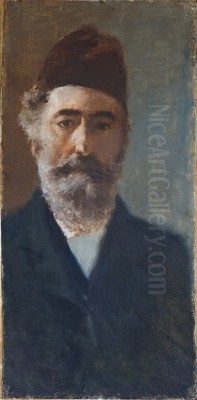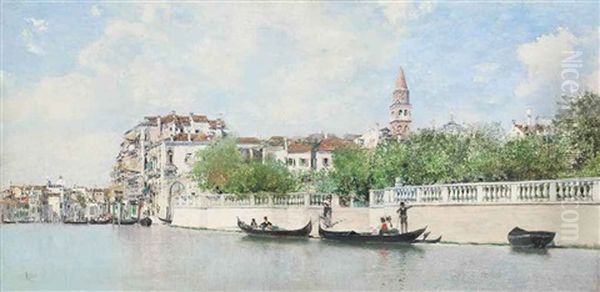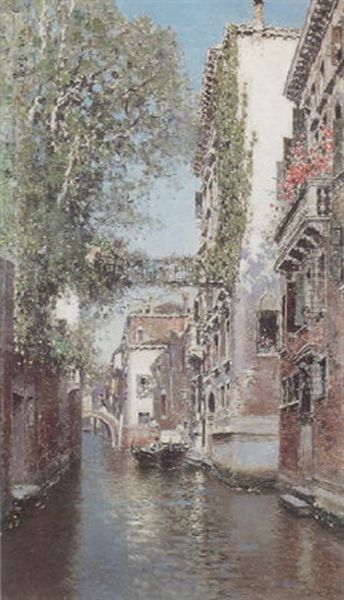
Martin Rico y Ortega stands as one of Spain's most distinguished painters of the 19th century, celebrated for his luminous landscapes and vibrant cityscapes, particularly those capturing the unique essence of Venice. Born in the historic town of El Escorial, near Madrid, in 1833, and passing away in his beloved Venice in 1908, Rico's artistic journey traversed the major artistic currents of his time, from Romanticism to Realism and the burgeoning influence of Impressionism. His work remains a testament to a keen observational skill wedded to a profound sensitivity to light and atmosphere.
Rico's legacy is defined by his ability to render architectural detail with precision while simultaneously imbuing his scenes with the transient effects of light and weather. He was a pivotal figure among Spanish artists who sought inspiration beyond their native borders, spending significant portions of his career in Paris and Venice, which became central hubs for his artistic development and international recognition. His paintings offer a window into the picturesque landscapes and urban environments of Europe, filtered through a distinctly Spanish sensibility combined with French avant-garde techniques.
Early Life and Academic Foundations
Martin Rico y Ortega's artistic path began formally in Madrid at the prestigious Real Academia de Bellas Artes de San Fernando. This institution was a cornerstone of Spanish art education, and it was here that Rico honed his foundational skills in drawing and painting. During his studies, he came under the tutelage of Jenaro Pérez Villaamil, a leading figure in Spanish Romantic landscape painting.
Pérez Villaamil's influence is discernible in Rico's early works, which often displayed the dramatic flair and picturesque qualities characteristic of the Romantic movement. Villaamil, known for his intricate architectural renderings and atmospheric landscapes, likely instilled in Rico a deep appreciation for detailed observation and the evocative power of place. This early grounding in Romanticism provided a base from which Rico would later evolve, incorporating newer artistic trends he encountered abroad.

The academic training at San Fernando emphasized traditional techniques, including careful draftsmanship and composition. This rigorous education equipped Rico with the technical mastery that would underpin his entire oeuvre, even as his style evolved towards greater freedom and luminosity. His formative years in Madrid laid the groundwork for his later explorations of light and landscape, establishing a solid technical foundation upon which his mature style would be built.
The Parisian Experience and Barbizon Connections
A pivotal moment in Rico y Ortega's career came in 1860 when he secured a government grant, enabling him to travel to Paris for further study. Paris, the undisputed center of the art world in the mid-19th century, exposed Rico to a ferment of new ideas and artistic movements that would profoundly shape his development. It was here that he encountered the Barbizon School, a group of painters dedicated to landscape painting directly from nature (plein air).
Rico immersed himself in this environment, seeking out artists associated with the Barbizon movement. He formed connections, reportedly through fellow Spanish artists like Raimondo Madrazo and Eduardo Zamacois, which led him to Charles-François Daubigny. Daubigny was a key figure in the Barbizon School, known for his river scenes and his practice of painting outdoors, often from a specially equipped studio boat.
Studying, or at least closely observing Daubigny's methods, had a significant impact on Rico. He embraced the practice of plein-air painting, moving away from purely studio-based work to capture the immediate sensations of light and atmosphere outdoors. This shift marked a departure from his earlier Romantic inclinations towards a more direct, realistic engagement with the landscape, a hallmark of the Barbizon ethos shared by artists like Jean-Baptiste-Camille Corot, Théodore Rousseau, and Jean-François Millet.
His time in Paris and his engagement with the Barbizon principles led to a noticeable evolution in his style. His landscapes began to exhibit a greater naturalism and a focus on the effects of light on the environment. This period saw him travel and paint scenes not only around Paris but also in Switzerland and other parts of France, honing his skills in capturing diverse terrains and atmospheric conditions. His work Washerwomen of Varenne (1865), depicting a scene along the Seine, exemplifies this phase, showcasing his growing interest in everyday rural life and realistic landscape representation, characteristic of the Barbizon influence.
The Enduring Friendship with Mariano Fortuny

While in Paris, around 1866, Martin Rico y Ortega met fellow Spanish artist Mariano Fortuny y Marsal. This encounter blossomed into a close friendship and a significant artistic dialogue that deeply influenced Rico's work. Fortuny, already gaining renown for his dazzling technique, vibrant color palette, and detailed genre scenes, shared with Rico a fascination with light and texture.
Fortuny's influence encouraged Rico to further brighten his palette and intensify his focus on capturing the brilliance of light and its reflections. Fortuny himself was known for his meticulous yet painterly approach, often working on small, highly finished panels that shimmered with detail and color. This resonated with Rico's own inclination towards detailed observation, but Fortuny's example pushed him towards a more vibrant and luminous rendering of surfaces and atmosphere.
The two artists shared an affinity for picturesque subjects and traveled together, including trips within Spain. Their artistic kinship was such that their styles, particularly in watercolor and small oil studies, sometimes showed remarkable similarities in their pursuit of capturing light effects and intricate detail. This friendship provided Rico not only with artistic stimulation but also with companionship within the expatriate Spanish artist community in Paris and later in Italy. Fortuny's tragically early death in 1874 was a significant loss, but his impact on Rico's handling of light and color remained evident throughout the latter's career.
Venice: The City of Light and Inspiration
While Rico traveled and painted throughout Europe, including Spain, France, Switzerland, and Germany, it was the city of Venice that captured his heart and became his most enduring subject. From the 1870s onwards, he spent increasingly long periods in Venice, eventually establishing a home there and remaining until his death in 1908. The city's unique combination of water, architecture, and ever-changing light provided him with endless inspiration.
Unlike the fleeting, atmospheric impressions sought by some Impressionists like Claude Monet in his Venetian series, Rico's approach combined detailed realism with a heightened sensitivity to light. He meticulously rendered the intricate facades of Venetian palaces, churches like Santa Maria Formosa, bustling canals, and quiet backwaters. Yet, his paintings are far from mere topographical records; they are imbued with the city's atmosphere – the shimmering reflections on the water, the interplay of sunlight and shadow on ancient stone, the humid haze of a summer afternoon.

Rico excelled at capturing the specific quality of Venetian light. His canvases often glow with a warm, Mediterranean radiance. He employed a bright, often high-keyed palette and lively brushwork to convey the vibrancy of the city. He explored Venice from various viewpoints, from panoramic vistas of the Grand Canal to intimate glimpses of gondolas moored in narrow waterways. His works often include figures – elegantly dressed ladies, gondoliers, merchants – adding life and narrative interest to the architectural settings, reflecting the daily life of the city.
His dedication to Venice made him one of the foremost painters of the city in the late 19th century, alongside artists like John Singer Sargent and Pierre-Auguste Renoir who also visited and painted there. However, Rico's long-term residency and prolific output established a particularly deep connection. His Venetian scenes became highly sought after, especially by American collectors, cementing his international reputation.
Artistic Style: Bridging Realism and Luminosity
Martin Rico y Ortega's artistic style is characterized by a unique synthesis of detailed Realism, learned through his academic training and Barbizon experiences, and a vibrant approach to light and color that aligns him with aspects of Impressionism. He never fully dissolved form into light in the manner of the core French Impressionists, always retaining a strong sense of structure and meticulous detail, particularly in architecture.
His technique involved careful drawing as an underpinning for his compositions. However, his application of paint was often lively and textured, using varied brushstrokes to capture the different surfaces of stone, water, foliage, and fabric. He employed a bright, luminous palette, skillfully rendering the effects of sunlight, shadow, and reflection. His paintings often possess a clarity and brilliance that make them immediately appealing.
While influenced by the plein-air practices of the Barbizon school, Rico often finished his larger canvases in the studio, working from detailed sketches and studies made outdoors. This allowed him to combine the immediacy of direct observation with carefully considered composition and finish. His works achieve a balance between accuracy and painterly effect, capturing both the specific details of a scene and its overall mood and atmosphere.
Compared to Spanish contemporaries like Joaquín Sorolla, who embraced a bolder, more purely Impressionistic style focused on capturing intense sunlight, Rico's work remained more grounded in detailed representation. Yet, his focus on light, his bright palette, and his choice of modern urban and landscape subjects clearly place him within the broader evolution of 19th-century painting away from academic conventions towards a more direct, light-filled depiction of the world. Other contemporaries exploring landscape and light included the Spanish painter Aureliano de Beruete and French artists like Armand Guillaumin.
Representative Works

Martin Rico y Ortega's prolific output includes numerous landscapes and cityscapes that showcase his distinctive style. While many focus on Venice, he also painted significant works based on his travels in Spain, France, and elsewhere. Some notable examples include:
A Canal in Venice: This title represents numerous works by Rico, capturing various scenes along the city's waterways. These paintings typically feature gondolas, reflections on the water, detailed architecture, and the vibrant play of light characteristic of his Venetian oeuvre.
Near the Grand Canal, Venice: Similar to the above, these works often provide wider views, showcasing the grandeur of the main thoroughfare, perhaps including famous landmarks, bustling boat traffic, and the unique atmosphere of the city.
The Bridge of Toledo, Madrid: Demonstrating his skill beyond Venice, this work captures a well-known landmark in his native Madrid, likely rendered with the same attention to architectural detail and atmospheric light seen in his Italian scenes.
Washerwomen of Varenne (1865): An earlier work reflecting his Barbizon influence, depicting a rural scene near Paris with a focus on naturalism and everyday life.
View from My Window: Often depicting the view from his residence, likely in Venice or Paris, these works offer a more personal perspective, framing a cityscape or landscape through the intimacy of a window view.
Torre de las Damas, Alhambra: Rico also painted scenes in Granada, capturing the beauty of the Alhambra palace. These works often highlight the intricate Moorish architecture and the interplay of light in its courtyards and gardens.
View of Cartagena: Representing his depictions of other Spanish locations, showcasing his versatility in capturing different landscapes and urban environments within his home country.
These titles, some generic representing common themes, point to the core subjects of his work: the interplay of architecture, water, and light, rendered with meticulous detail yet infused with atmospheric vibrancy. His paintings consistently demonstrate his mastery in capturing the specific character of each location.
International Recognition and Success
Martin Rico y Ortega achieved considerable success and recognition during his lifetime, both within Spain and internationally. His participation in major exhibitions, particularly in Paris, was crucial to building his reputation. He exhibited regularly at the Paris Salon, the premier art exhibition venue of the era.
His talent was formally acknowledged through several prestigious awards. He won medals at the Paris Salons and notably received accolades at the Paris Universal Expositions of 1878 and 1889. These international fairs were major cultural events, and success there significantly boosted an artist's profile. His achievements were further crowned when he was awarded the Légion d'honneur (Legion of Honour) by the French government, a significant mark of distinction.
Rico's paintings found particular favor with collectors in France and, significantly, in the United States. American collectors during the late 19th and early 20th centuries were actively acquiring European art, and Rico's bright, detailed, and picturesque views, especially of Venice, held great appeal. This strong market demand contributed to his financial success and the wide dispersal of his works into international collections. Artists like John Singer Sargent, an American expatriate himself, also painted Venice, indicating the city's popularity among artists and patrons alike during this period. Rico's success placed him among the leading European landscape and cityscape painters of his generation sought after by discerning collectors.
Wider Circle and Contemporaries
Martin Rico y Ortega operated within a rich network of artistic exchange in the latter half of the 19th century. His career intersected with several major artistic figures and movements. His direct engagement with the Barbizon school connected him to figures like Charles-François Daubigny, Jean-François Millet, and the broader circle including Jean-Baptiste-Camille Corot and Théodore Rousseau.
His time in Paris also brought him into the orbit of the Impressionists, although he never fully adopted their stylistic innovations. He would have been aware of, and likely knew, key figures such as Edouard Manet, Claude Monet, and Pierre-Auguste Renoir. While his style remained more detailed, his interest in light, contemporary subjects, and plein-air work paralleled some of their concerns. His friendship with Mariano Fortuny connected him to another circle of Spanish expatriate artists and those interested in Orientalist and genre scenes executed with brilliant technique.
In Spain, his contemporaries included landscape painters like Aureliano de Beruete, who also embraced plein-air painting and was influenced by Impressionism, and the immensely popular Joaquín Sorolla, known for his dazzling depictions of Spanish sunlight and coastal scenes. Rico's initial training under Jenaro Pérez Villaamil linked him to the earlier Spanish Romantic tradition.
His international connections extended to artists visiting Venice, such as the American John Singer Sargent, whose Venetian watercolors and oils offer an interesting comparison in their approach to the city's light and architecture. He also knew French Realist and Impressionist-aligned painters like Armand Guillaumin. This web of connections underscores Rico's position within the mainstream, yet distinct, currents of European art, bridging Spanish traditions with French innovations.
Later Life, Legacy, and Collections
In his later years, Martin Rico y Ortega continued to divide his time, primarily between Paris and his beloved Venice, where he ultimately passed away in 1908. He remained artistically active, continuing to produce luminous views of the Venetian cityscape and canals that had become his signature subject. His dedication to his craft endured throughout his life.
Beyond his easel painting, Rico also engaged in illustration. Late in his career, he served for a time as the artistic director for the prominent Spanish magazine La Ilustración Española y Americana, demonstrating his respected position within the broader Spanish cultural scene. This role involved overseeing the visual content of the publication, further disseminating his aesthetic sensibilities.
Rico's legacy rests on his mastery of landscape and cityscape painting, particularly his Venetian scenes. He successfully synthesized the detailed realism of his academic training with the atmospheric concerns and brighter palette associated with the Barbizon School and Impressionism. He stands as a key figure in 19th-century Spanish art, representing those artists who engaged deeply with international trends while retaining a unique sensibility. His work continues to be admired for its technical skill, evocative beauty, and ability to capture the enduring allure of Venice.
Market Presence and Museum Collections
Martin Rico y Ortega's works remain highly regarded in the art market and are held in numerous prestigious public and private collections worldwide. His paintings, especially his Venetian views, appear regularly at major auction houses like Christie's and Sotheby's, often commanding significant prices. For instance, a signed painting achieved $82,500 at Cottone Auctions, reflecting the continued demand among collectors. Even smaller works maintain considerable value, indicating his established market presence.
His paintings and drawings are well-represented in major museum collections, particularly in Spain and the United States. Key institutions holding his work include:
The Prado Museum, Madrid, Spain
Museo de Bellas Artes de Bilbao, Spain
The Metropolitan Museum of Art, New York, USA
The Art Institute of Chicago, USA
Brooklyn Museum, New York, USA
The Walters Art Museum, Baltimore, USA
Mildred Lane Kemper Art Museum, St. Louis, USA
Minneapolis Institute of Art, USA
Currier Museum of Art, Manchester, New Hampshire, USA
Tweed Museum of Art, University of Minnesota Duluth, USA
Provo Museum of Art, Utah, USA (holding works like School Courtyard, 1871)
The presence of his art in these diverse and important collections underscores his historical significance and the enduring appeal of his luminous and meticulously crafted visions of Europe's landscapes and cities. His work offers a captivating glimpse into the world as seen through the eyes of a Spanish master navigating the artistic currents of the 19th century.